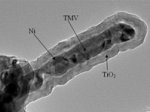Researchers at the University of Maryland’s A. James Clark School of Engineering and College of Agriculture and Natural Resources are harnessing properties of the tobacco virus to create a new generation of highly efficient batteries.
The tobacco mosaic virus (TMV), affects not only tobacco, but tomatoes, peppers, and other vegetation too. While its destructive nature causes millions of dollars worth of damage, the researchers have discovered attributes of the virus that they can harness to build tiny components for futuristic lithium batteries.
By modifying the TMV rod-like structure to bind to the metallic surface of a battery electrode and coating the rods with a conductive thin film that acts as a current collector, the researchers say they can greatly increase a battery electrode surface area and its capacity to store electricity; plus allow for fast charge/discharge times.
The process is simple, inexpensive, and renewable and the team says fabricating batteries can be scaled up to meet industrial production needs.
“The resulting batteries are a leap forward in many ways and will be ideal for use not only in small electronic devices but in novel applications that have been limited so far by the size of the required battery,” said Reza Ghodssi, director of the Institute for Systems Research and Herbert Rabin Professor of Electrical and Computer Engineering at the Clark School.
The researchers say the new batteries will have to a staggering 10-fold increase in energy capacity over a standard lithium ion battery. The potential for energy storage for solar power and other forms of renewable energy are obvious; particularly in off grid situations where deep cycle batteries are required, but also in providing storage for grid applications.
Research into building a better battery has seen a great deal of outside-the-square thinking in recent years. Previously we’ve covered a number of novel battery developments, including
– Cavern battery
– Beltway battery
– Virus battery
– Lithium air battery
– Silicon air battery
– Ice battery
– Hot water battery
– Molten salt battery
– Liquid battery
– Flywheel battery
– Supercapattery
Source and Image Credit – University of Maryland







































